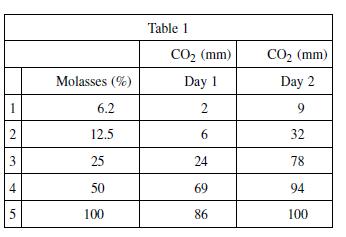Which of the following is the most likely reason that a 15% sucrose solution was used in
Question:
Which of the following is the most likely reason that a 15% sucrose solution was used in Experiment 3? Results showed that:
F. in experiment 1, yeast grew most efficiently in a 15% sucrose solution.
G. yeast produced the most carbon dioxide in a 15% sucrose solution in Experiment 2.
H. an amount of sucrose greater than 15% did not increase carbon dioxide production in either Experiment 1 or Experiment 2.
J. A 15% sucrose solution was the minimum concentration needed to produce yeast growth.
Experiment 1
Since yeast needs sucrose to ferment and molasses is 60% sucrose, scientists first study yeast grown in molasses. Five test tubes are filled with .4 grams of yeast and various molasses concentrations. Carbon dioxide levels are measured as an indication of fermentation for each test tube after one day and again after two days. These levels are shown in Table 1.

Experiment 2
Five different test tubes are filled with .4 grams of yeast and various pure sucrose dilutions. Carbon dioxide levels are then measured as an indication of fermentation after one and two days. These levels are shown in Table 2.

Experiment 3
Eight more test tubes were filled with .4 grams of yeast and a 15% sucrose solution. Various combinations of ammonium sulfate, potassium dihydrogen phosphate, minerals, and vitamins were added to the test tubes. Carbon dioxide levels were measured after one and two days. These levels are shown in Table 3.

Step by Step Answer:






